|
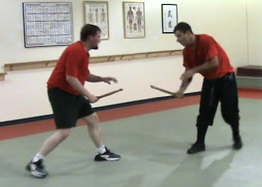 About
the ARMA About
the ARMA
Real
World Skills From Real History
ARMA - the Association for
Renaissance Martial Arts, is an educational non-profit organization
dedicated to the study and practice of historical fencing and the
exploration and promotion of our Western martial heritage.
The ARMA focuses on the
interpretation and legitimate reconstruction of Medieval and
Renaissance combat systems as a modern discipline. The ARMA
endeavors to approximate historical fighting skills through a
curriculum of reconstructed techniques, principles, and methods for
using a variety of swords, spears, shields, staff weapons, daggers, and
unarmed grappling and wrestling skills as taught in numerous surviving books and
manuscripts.
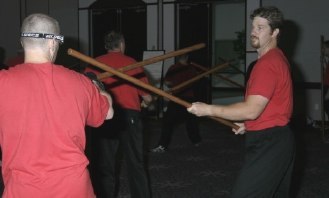 The
ARMA’s efforts are directed toward resurrecting
and recreating a legitimate craft of European fighting
skills in a manner that is historically valid and
martially sound. We rely for our source
material upon the dozens of rare surviving manuals
of Medieval and Renaissance Masters of Defence. The
ARMA’s efforts are directed toward resurrecting
and recreating a legitimate craft of European fighting
skills in a manner that is historically valid and
martially sound. We rely for our source
material upon the dozens of rare surviving manuals
of Medieval and Renaissance Masters of Defence.
The ARMA was established
to promote the study of European fighting arts and arms & armor
of the 15th – 17th
centuries. We are first and foremost a martial arts
association.
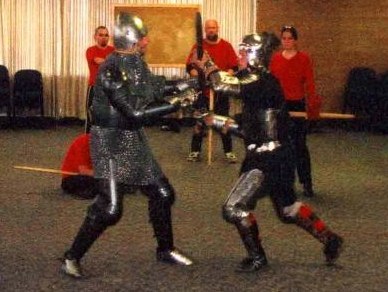 The
earnest approach we advocate differs substantially
from much of the fluff and fantasy-oriented escapism
that in the past has occupied this subject.
The ARMA does not conduct costumed role-playing nor
hold tournaments and sporting competitions.
We also do not perform choreographed fighting stunts.
Accurate investigation and interpretation of historical
European fighting skills is our primary objective.
Our emphasis is also on Spathology
–the study of swords. The
earnest approach we advocate differs substantially
from much of the fluff and fantasy-oriented escapism
that in the past has occupied this subject.
The ARMA does not conduct costumed role-playing nor
hold tournaments and sporting competitions.
We also do not perform choreographed fighting stunts.
Accurate investigation and interpretation of historical
European fighting skills is our primary objective.
Our emphasis is also on Spathology
–the study of swords.
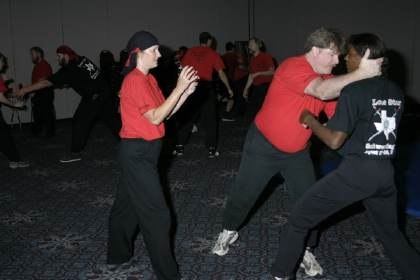 The
ARMA is a leading voice in the resurrection and revival
of lost European fighting arts from the late Medieval
period through the mid-17th century. Founded
in 1992, and online since 1996, (originally under
the name “HACA”) we have been at the forefront
of the Medieval and Renaissance fencing studies revival.
The ARMA website is the leading online resource for
the subject. The ARMA’s influence and popularity
has been an inspiration to many. In a sea of
misinformation, misconception, and sheer fiction,
ours is one of few islands of reliable experience
and information. We continually revise and amend
our training aids, study materials, and curricula. The
ARMA is a leading voice in the resurrection and revival
of lost European fighting arts from the late Medieval
period through the mid-17th century. Founded
in 1992, and online since 1996, (originally under
the name “HACA”) we have been at the forefront
of the Medieval and Renaissance fencing studies revival.
The ARMA website is the leading online resource for
the subject. The ARMA’s influence and popularity
has been an inspiration to many. In a sea of
misinformation, misconception, and sheer fiction,
ours is one of few islands of reliable experience
and information. We continually revise and amend
our training aids, study materials, and curricula.
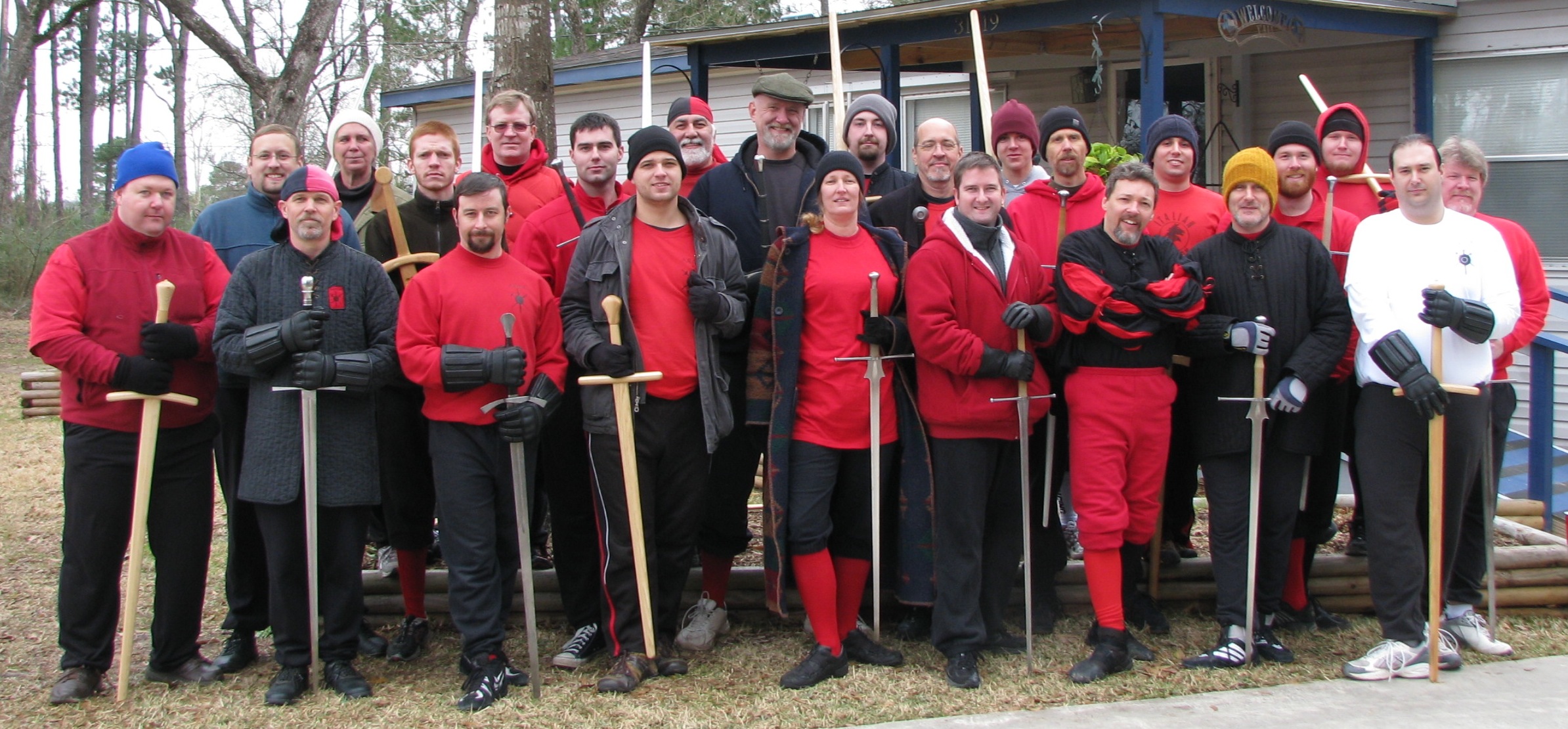
The modern
study of Renaissance martial arts
- History, Heritage, Exercise, Camaraderie, and Self-Defense.
The word “tradition” is from the Latin, tradere,
and in the Medieval era its meaning was to transmit, as in the legacy
of knowledge and wisdom each generation may pass on to the next. There
is no question that in Western civilization transmission of arts and
sciences has long taken the form of written technical words as well as
illustrations of movement. By no means was it limited only a “living”
practice spoken person to person. What
the ARMA attempts to do is revitalize a martial tradition whose methods
and techniques - as an intangible cultural heritage - have been preserved almost exclusively in written
records, illustrations, iconography, and surviving artifacts. Our study
today takes the form of cultural revitalization to revive and
perpetuate elements forgotten traditions of a lost and endangered
culture. In doing this, ours is a collective educational effort to
revive, reconstruct, redevelop, and reclaim a lost heritage. For
this challenge, the ARMA provides a means of practice and supply a
curriculum of training. We offer resources and advice. We offer
training tips and information. We offer experience and expertise. And
we present a community and fellowship. But in return, we expect
commitment, sincerity, integrity, and martial spirit, along with
support for our credo and our standards. Members are more than just
subscribers. We are partners working together to one again explore a
fighting discipline.
|
|
Our
Purpose:
- Study European arms and armor
from the point of view of their historical function and use.
- Study historical source
literature as instructional fighting guides.
- Examine historical European
martial culture within a broader historiographic context.
- Study, Interpret, Practice,
Promote, and Teach the martial arts of Renaissance Europe.
Our Objectives:
- The ARMA offers classes,
workshops, and seminars through our continually revised system of
established drills and exercises (Armatura).
Our curriculum also includes a Certification & Ranking
structure for students and instructors.
- The ARMA provides a Training
Program allowing students to learn and practice within a common
structure that is historically valid and martially sound.
- The ARMA seeks to advance the
quality of skills demonstrated with Medieval and Renaissance weaponry.
- The ARMA offers Associate
Members a variety of benefits, advantages, and opportunities in pursuit
of their studies.
- The ARMA attempts to improve the
relationship between practitioners and academics in order to stimulate
the exchange of knowledge and encourage understanding of historical
European combat skills.
- The ARMA makes it a primary aim
to raise the level of scholarship within the historical fencing
community with its emerging interest in source texts.
Our
efforts to combine academic and athletic rigor in this subject is a
conscious following of the idea of the Renaissance man with his
combining of liberal and martial arts.
Read
more here:
Introduction to
Historical
European Martial Arts
|
|
A large part of the ARMA’s energy
is directed at interpretation and integration of translated source
material into practical hands-on curriculum. Interpretation
and reconstruction of Medieval and Renaissance fighting arts are still
only in their infancy. Bringing to public study the numerous manuals of
the Masters of Defence is an important part of our efforts. The ARMA
encourages and supports efforts at translating these invaluable texts.
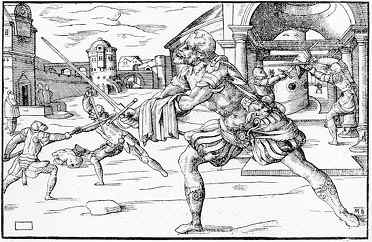 The
wealth of fighting manuals currently being studied
by many in the historical fencing community is only
the tip of a very large iceberg. We have only
just begun to scratch the surface in examining the
profusion of material now coming to light. Avoiding
misinterpretation and error in our study is a continual
challenge. While the Internet is frequently awash
with inaccurate information on our subject, the growing
community of serious enthusiasts and amateur researchers
of Medieval and Renaissance fighting arts has long
been in need of reputable sources of guidance. The
wealth of fighting manuals currently being studied
by many in the historical fencing community is only
the tip of a very large iceberg. We have only
just begun to scratch the surface in examining the
profusion of material now coming to light. Avoiding
misinterpretation and error in our study is a continual
challenge. While the Internet is frequently awash
with inaccurate information on our subject, the growing
community of serious enthusiasts and amateur researchers
of Medieval and Renaissance fighting arts has long
been in need of reputable sources of guidance.
In the effort to bring a higher degree of integrity,
dignity, and authority
to these efforts, the ARMA has gathered a list of knowledgeable
specialists in several major fields on which we can call on as
reference sources. As ARMA Expert Consultants we
have historians, anthropologists, linguists, forensic pathologists,
curators, armorers, swordsmiths, metallurgists, researchers, scholars,
fencers, martial artists, and reenactors. Our panel includes such noted
individuals as Dr. Sydney Anglo, David Edge of the Wallace Collection,
John Waller of the Royal Armories, and a variety of historians,
professors, scientists, bladesmiths, and craftsmen.
We are
passionate about our subject and it is our sincere wish to see
historical European martial arts acquire the respect and attention they
deserve.
Our intent is directed toward raising the credibility, legitimacy, and standards
of practice within
this field while redeveloping genuine martial skills and teaching
ability. To this end, we have established a long-term research effort
as well as a proven Training
Program.
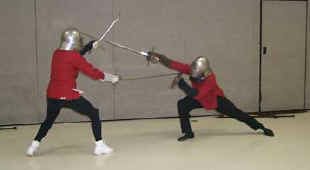 “That there are persons of
mistaken ideas in almost every Art or Science, is what few will deny.
Yet I am inclined to believe there are more erroneous opinions
entertained with regard to the Art of using the Sword than on most
other subjects.” “That there are persons of
mistaken ideas in almost every Art or Science, is what few will deny.
Yet I am inclined to believe there are more erroneous opinions
entertained with regard to the Art of using the Sword than on most
other subjects.”
|
|
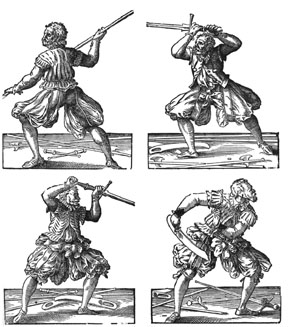 We
do not study historical fencing so that it will be
incomprehensible to all but a narrow group of specialists,
merely fuel escapist role-playing, or be devoid of
any practical application. Rather, we explore it because
we love history and enjoy the improvement it provides
our understanding and practice of the craft as its
own end. Inherent in this is the idea within Renaissance
culture of the pursuit of excellence—the joy
of individual distinction and accomplishment—as
exemplified in chivalric romance and articulated by
Humanists scholars and pursued by courtier gentlemen. We
do not study historical fencing so that it will be
incomprehensible to all but a narrow group of specialists,
merely fuel escapist role-playing, or be devoid of
any practical application. Rather, we explore it because
we love history and enjoy the improvement it provides
our understanding and practice of the craft as its
own end. Inherent in this is the idea within Renaissance
culture of the pursuit of excellence—the joy
of individual distinction and accomplishment—as
exemplified in chivalric romance and articulated by
Humanists scholars and pursued by courtier gentlemen.
In the
ARMA we are not content to merely speculate upon the manner in which a
technique or action might theoretically be done at speed. We are not
satisfied until we confidently understand their performance in a
martial and repeatable manner.
|
|
"With Knightly joy,
as you
will note,
The
art of fencing I did promote
With
axe and halberd, staff and sword,
As it
did please my royal Lord;
All
done by rule and properly
So the
true basis you may see"
- Hans Hollywars, 15th century
The ARMA was the first comprehensive attempt at an
organization established specifically to advance scholarship into, and
practice of, Medieval and Renaissance fighting arts, and offer a modern
historically based curricula. ARMA's intention is not the
"play and display" way. We place concern exclusively on acquiring
technical knowledge and physical skills, rather than theoretical or
academic understanding focused only on form –as these were not what the
craft historically was all about.
The ARMA web site is structured for two
primary functions. The first is to introduce ARMA's purpose and methods
to interested parties, and the second is to educate the community while
supporting individual Members and Study Groups.
The ARMA idea is to allow people to
freely and seriously practice this subject without the concerns of
staged fighting and sporting play, or the distractions of role-playing
and fantasy.
For this, we have supplied general
material on our training methods and sparring systems, noteworthy
articles and essays, historical manuals and scholarly
works, research material and suggested reading, relevant or
worthwhile links, a listing of ARMA Members & Study Groups as
well as other interested persons, discussion Forums, plus a range of
other items from our international network of members and fellow
enthusiasts within the historical European martial arts community.
The ARMA website offers a "homebase" for
sharing and exchanging information in the study of historical fighting
skills and the function and use of historical arms and armor. Above
all, promoting the accurate reconstruction and replication of our
Western martial-heritage is the site's mission.

Our
Website features:
·
Online Historical Manuals
·
Articles & Essays
·
Study Materials
·
Training Tips
·
Research Forum
·
Reading List / Bibliography
·
Book Reviews & Interviews
·
Photo & Video Gallery
·
National Training Program
·
Member’s Area Resources
·
Youth Page
·
Private Member’s Area
|
|
|
|
 |
|
We
have known for some time that there is a good deal of misconception and
misinformation on historical European martial arts, and many are
sincerely working at changing this. But there is also a large section
of the interested public who are entirely at a loss as to how to get
involved, how to start training, what to practice, and how they can
enjoy studying this subject on their own. In effect, this is
what a large portion of the ARMA site is already about.
Our
recent effort to follow “old swordplay” is not the first.
Such an effort actually was underway over 100 years ago.
Several Victorian-era military men were fencers interested in the
history of swordplay. Their legacy is with us in the current
resurgent interest in historical fencing.
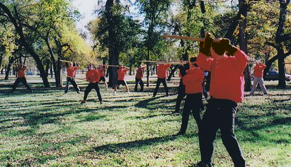
Rather
than an academic game of the fencing salle or a skill of the fading
duel of honor, these soldier-scholar antiquarians viewed swordsmanship
as practical knowledge that was still a necessity for military men.
Instead of using then current systems of classical fencing, they
pursued as their guide the old forgotten styles found in the historical
manuals.
In many
ways, today's enthusiasts of Historical European martial arts
attempting to construct a modern curricula are the inheritors of the
efforts by these “private gentleman devoted to the noble science.”
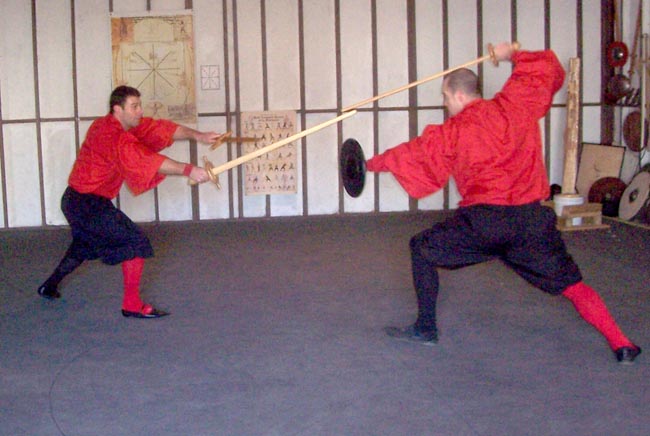
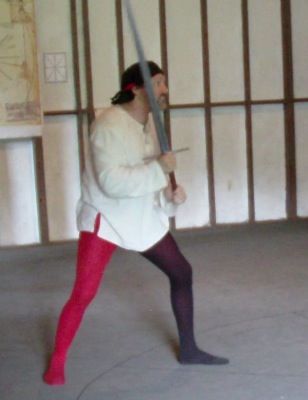
|
|
|
Why ARMA?
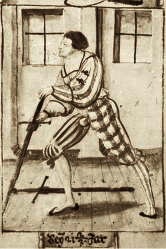 ARMA’s
conceptualization has been largely influenced by the work
of Dr. Sydney Anglo as
presented in his monumental and revolutionary book, The
Martial Arts of Renaissance Europe (Yale University
Press 2000). As our official senior adviser, Dr. Anglo
has been instrumental in retooling our vision of historical
fencing. His research, along with other recent advances
in this subject, has changed the face of fencing and martial
arts and had a profound impact on our subject. ARMA’s
conceptualization has been largely influenced by the work
of Dr. Sydney Anglo as
presented in his monumental and revolutionary book, The
Martial Arts of Renaissance Europe (Yale University
Press 2000). As our official senior adviser, Dr. Anglo
has been instrumental in retooling our vision of historical
fencing. His research, along with other recent advances
in this subject, has changed the face of fencing and martial
arts and had a profound impact on our subject.
The word arma
(pronounced ‘arm-uh’) in
Latin as well as Italian, Spanish, and Portuguese means, appropriately
enough, “weapon”. In the 11th century Anselm
referred to Armati
or the "heavily armed ones". For knights in 13th century
France, it also referred to “the valor of a fighter,” appropriate, not
only in the sense of the historical period itself, but also the idea of
renewal and revival, of reawakening. The word Renaissance, meaning
literally “rebirth” or “renewal”, describes the radical and
comprehensive changes that took place in European culture during
roughly the 14th to 16th centuries. The Renaissance is the
name given the great intellectual and cultural movement which occurred
in these centuries. Rebirth was often a key concept in
Medieval and Renaissance literature, which spoke of “restoration” and a
“reflowering” of civilization. The notion of a new age of
rebirth itself actually began in the 14th
century with the
poet Petrarch. This view took hold in the Italian states during the 15th century
and was termed the rinascità.
Currently we are witnessing an unprecedented resurgence and recovery—a renaissance—in lost
knowledge of historical European fighting arts!
|
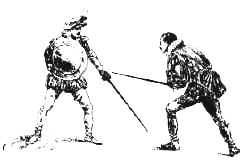 Many
historians describe the Renaissance as beginning in the early
1400s or even prior. The idea of a “Renaissance”
is itself unique to Western Civilization. Only Western
Europe experienced this distinctive transforming period which
gave rise to so many accomplishments of human progress.
Although the Renaissance is considered a period of rebirth
in Western Civilization, it also saw greater devastation and
larger, bloodier wars than did either the Middle Ages or classical
ancient world. The ARMA is of course equally committed
to Medieval combat skills and Medieval fighting manuals as
it is to those of the "Renaissance period". While the
ARMA focuses on both eras, in this subject the two ages are
not that clearly separated. Medieval and Renaissance
fighting arts are intertwined and historians find it difficult
to offer a precise demarcation between them. The fighting
arts we study date from at least the 13th century and show
a clear continuity in principles and concepts into the 17th.
Since 1954, the Renaissance Society of America (www.rsa.org),
the leading academic organization in the Americas for the
interdisciplinary study of the period 1300-1650 in Western
history, has also used the same time frame for its working
definition of the "Renaissance." Many
historians describe the Renaissance as beginning in the early
1400s or even prior. The idea of a “Renaissance”
is itself unique to Western Civilization. Only Western
Europe experienced this distinctive transforming period which
gave rise to so many accomplishments of human progress.
Although the Renaissance is considered a period of rebirth
in Western Civilization, it also saw greater devastation and
larger, bloodier wars than did either the Middle Ages or classical
ancient world. The ARMA is of course equally committed
to Medieval combat skills and Medieval fighting manuals as
it is to those of the "Renaissance period". While the
ARMA focuses on both eras, in this subject the two ages are
not that clearly separated. Medieval and Renaissance
fighting arts are intertwined and historians find it difficult
to offer a precise demarcation between them. The fighting
arts we study date from at least the 13th century and show
a clear continuity in principles and concepts into the 17th.
Since 1954, the Renaissance Society of America (www.rsa.org),
the leading academic organization in the Americas for the
interdisciplinary study of the period 1300-1650 in Western
history, has also used the same time frame for its working
definition of the "Renaissance."
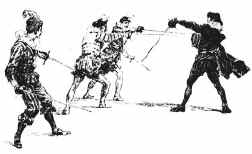 However,
since the vast majority of our source texts are from post
1400, with the only evidence for “Medieval”
systems of fencing coming from a mere two or three earlier
texts, the phrase “Renaissance martial arts”
is thus actually more fitting and accurate for this subject.
While a distinction between what constitutes the
martial arts of the true Middle Ages and those of the actual
Renaissance can actually be difficult to draw, when it comes
to actual “Medieval” text sources, at present
only one surviving text from the late 1200s and one from
the late 1300s are known. This stands in contrast to dozens
from the period c.1350-1650. However,
since the vast majority of our source texts are from post
1400, with the only evidence for “Medieval”
systems of fencing coming from a mere two or three earlier
texts, the phrase “Renaissance martial arts”
is thus actually more fitting and accurate for this subject.
While a distinction between what constitutes the
martial arts of the true Middle Ages and those of the actual
Renaissance can actually be difficult to draw, when it comes
to actual “Medieval” text sources, at present
only one surviving text from the late 1200s and one from
the late 1300s are known. This stands in contrast to dozens
from the period c.1350-1650.
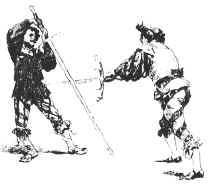 We
understand the choice of some to employ the label “Medieval
martial arts” for Medieval fencing activities or those
specifically pursuing later 16th and 17th century styles
calling their pursuit “Renaissance martial arts”.
Yet, while the civilian method of the later foyning rapier
was certainly exclusive to the Renaissance, and knightly
sword and shield combat all but exclusive to the Middle
Ages, the methods used in the 14th and 15th centuries found
continued application and refinement in the 16th.
Rather than attempt to draw a distinct line between the
combative systems of the Middle Ages and those of the Renaissance
(or be forced to always say “Medieval and Renaissance
martial arts”), we choose to apply the term Renaissance
martial arts to the whole. Though each period had
distinctive elements to their fighting skills, their overall
foundation is one of continuity and shared legacy. We
understand the choice of some to employ the label “Medieval
martial arts” for Medieval fencing activities or those
specifically pursuing later 16th and 17th century styles
calling their pursuit “Renaissance martial arts”.
Yet, while the civilian method of the later foyning rapier
was certainly exclusive to the Renaissance, and knightly
sword and shield combat all but exclusive to the Middle
Ages, the methods used in the 14th and 15th centuries found
continued application and refinement in the 16th.
Rather than attempt to draw a distinct line between the
combative systems of the Middle Ages and those of the Renaissance
(or be forced to always say “Medieval and Renaissance
martial arts”), we choose to apply the term Renaissance
martial arts to the whole. Though each period had
distinctive elements to their fighting skills, their overall
foundation is one of continuity and shared legacy.
The ARMA is the official representative for the martial arts of Renaissance Europe to the World Martial Arts Union (WoMAU). Under the official patronage of UNESCO,
the WoMAU is a Non-Governmental Organization for sustaining Intangible
Cultural Heritage.
|
Weapon exercises were known to the Romans as
Armatura. In the Renaissance, an Armígero was a bearer or professor of
arms. A 16th century arms and armor making guild in Pisa was
known as the Armaroli. In 1611, John Florio defined the
Italian word A’rma as “any weapon or armor”. The motto of the
16th century Royal Artillery company in England was, Arma pacis fulcra
– “armed strength for peace”, from the Roman proverb, “Arms are the
props of peace”, meaning essentially peace through strength. This holds
true for us today.
The historical masters were "still
participating in a living tradition" but "Nowadays, that option is no
longer available to us." - Dr. Sydney Anglo, leading expert on
historical fencing treatises. (The
Martial Arts of Renaissance Europe, p. 94)
|
"Cunning defeats any strength"
- The Master Filippo Vadi
c.1482
"Practice is better than Art,
because your practice will suffice without art, while the art means
nothing without practice."
- Hanko Doebringer
14th century
|
|
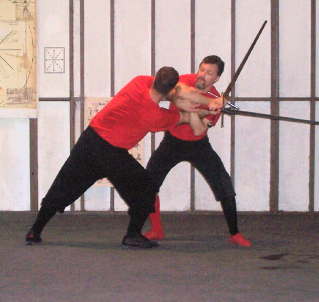 The
ARMA Program The
ARMA Program
Our
energies and efforts are naturally devoted toward developing our
fellows within the standards of our program's curricula; one that sets
the highest example of martial spirit, physical ability, and
self-defense skills in this craft.
What makes the
ARMA’s knowledge and training program unique? The
ARMA classes, workshops, and seminars utilize our continually revised
system of established drills and exercises---Armatura.
The ARMA is no mere Internet group of
costumed reenactors that popped into existence with the recent
explosion of the World Wide Web. Ours is not a curriculum
derived from 19th century fencing styles or
modern theatrical combat theories. The ARMA system reflects
almost a decade of use in exploring the subject of Medieval and
Renaissance arms and armor and associated fighting skills.
From early in its formation our aim has been to re-develop
genuine ability through serious study of surviving fencing texts.
Too
many martial arts today are watered down and hyped up while missing the
vital middle ground. As pursued within the ARMA Study
Approach,
our historical fighting craft does not suffer this defect.
The ARMA's
system is specifically designed for individuals training by
themselves or learning alone without guidance, but also focuses
on working together as a fighting guild in separate "Study Groups."
We attempt
to follow the model of the historical masters and schools, and
that means genuine fighting skills matched with genuine appreciation
for Renaissance martial culture. That also means we are not
an assortment of loners and amateur cliques all posturing for
prestige and vying for influence, pushing their commercial products,
and maneuvering for credit in promoting sport contests. Given
the nature of martial arts study in the modern world, all of
this kind is more or less inevitable. A better alternative is
also inevitable: a renewal effort such as what the ARMA represents,
as a truer approach to sincerely emulating these lost martial
traditions. Our association takes a long term view to the subject
and the individual student. There is no better way to express
it than to say what we are all about is history, heritage, self-defense,
and camaraderie.
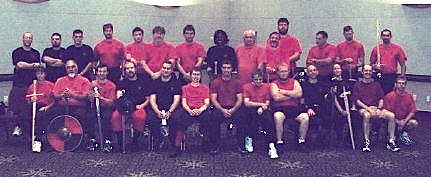
"I believe the adoption of any curriculum for the practice of a martial
art is not just a matter of holding policies toward training or
techniques, rather, it's about having a philosophy of learning a
combative discipline. " - John Clements, ARMA Director
The ARMA Study Approach and
Training Methodology: Our Study Approach is essentially a
means of researching and interpreting Medieval and Renaissance martial
arts. Our Training Methodology is a means of reconstructing and
practicing historical fencing skills. Together they present
an innovative and influential system for exploring and reviving our
Western martial heritage.
Drills, Exercises,
Free-Play, and Test-cutting:
There is an interesting parallel to the
ARMA method found within one of the world's foremost elite infantry
fighting forces –the United States Marine Corps.
To train its recruits in bayonet fighting skills, the Marines rely on
three tools: steel bayonets, wooden bayonets, and padded bayonets.
Actual bayonets are used for acquiring familiarity with the weapon and
for practice in stabbing at targets. Wooden practice bayonets are
employed for safer drills and exercises, both alone and with a partner.
Finally, padded pugil-sticks are used in
full-contact sparring lessons. The Marine Corps, ever known
for the pragmatic no-nonsense approach to combat training, found the
best instruction was gained from the combination of unique lesson
provided by each tool.
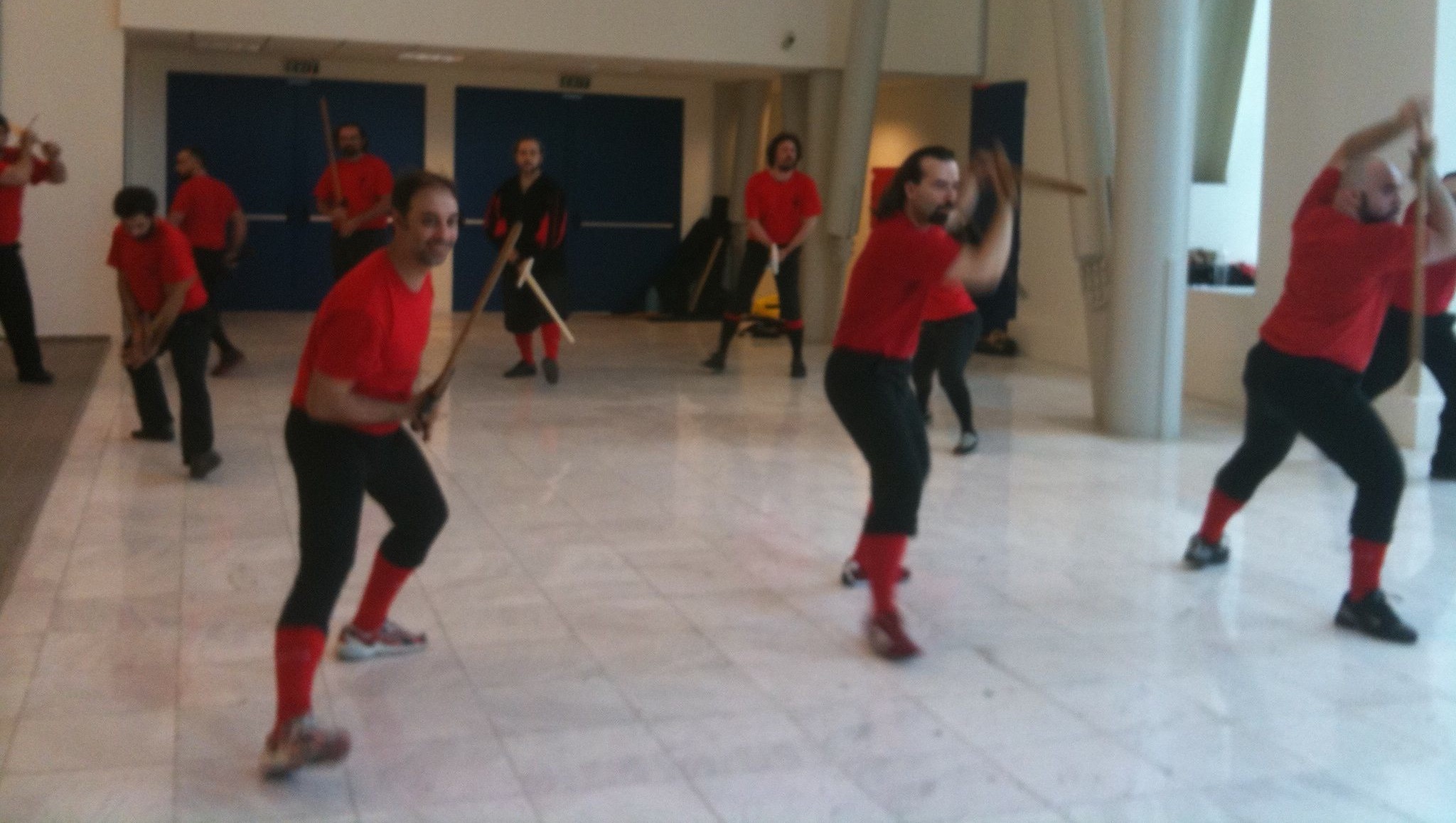 The
ARMA believes understanding of Medieval and Renaissance fencing
must involve much more than simply posing and “dancing”
with a weapon, or scoring imaginary “points” in
a game, and certainly far more than artistically “faking”
a fight. To demonstrate sound fighting skills with documented
historical techniques requires not choreography, nor 19th century
duelling styles, but martial ability and historical authenticity.
We felt a problem for the modern student of Medieval and Renaissance
fencing was that, while there already was an established sport
fencing community, an established theatrical fencing community,
an established fantasy fencing and established living-history/reenactment
community, there previously was no recognized and respected
“Martial Arts” community. Approaching this subject
more holistically, and as martial artists, not sportsmen, performers,
or role-players, the ARMA felt these other communities only
touched on, but they did not embody a martial arts approach
(and certainly do not exclusively represent it). Thus, the ARMA
(until 2001 known previously as “HACA”) re-established
itself for individuals to pursue Medieval and Renaissance martial
arts with like-minded colleagues sharing a love for historical
European weapons and swordsmanship! The
ARMA believes understanding of Medieval and Renaissance fencing
must involve much more than simply posing and “dancing”
with a weapon, or scoring imaginary “points” in
a game, and certainly far more than artistically “faking”
a fight. To demonstrate sound fighting skills with documented
historical techniques requires not choreography, nor 19th century
duelling styles, but martial ability and historical authenticity.
We felt a problem for the modern student of Medieval and Renaissance
fencing was that, while there already was an established sport
fencing community, an established theatrical fencing community,
an established fantasy fencing and established living-history/reenactment
community, there previously was no recognized and respected
“Martial Arts” community. Approaching this subject
more holistically, and as martial artists, not sportsmen, performers,
or role-players, the ARMA felt these other communities only
touched on, but they did not embody a martial arts approach
(and certainly do not exclusively represent it). Thus, the ARMA
(until 2001 known previously as “HACA”) re-established
itself for individuals to pursue Medieval and Renaissance martial
arts with like-minded colleagues sharing a love for historical
European weapons and swordsmanship!
Read
more here:
The ARMA System for Renaissance Martial Arts Practice
The ARMA's main
program consists of our research efforts and Training
Program
– A Western martial arts study system for Student
Ranking or Instructor Certification. Using the ARMA Study Approach and
Training Methodology, it offers students the chance to exchange ideas
as well as benefit from the expertise offered by ARMA instructors and
senior students. We have a developed curricula of classes and
workshops. Above all we are a martial arts organization with high
standards and a code of conduct but total autonomy in sparring
guidelines. Sportifying the historical Art of of Defense into
artificial contests is not among our goals or interests.
|
There is no question that there were men in the age
who were experts at fighting. There is also no question some of them
wrote down how to do this. They described their teachings by giving
names to the actions and moves they knew and to the concepts they
devised for both. It is this very body of lost knowledge that we now
are attempting to learn.
Among
practitioners of historical fencing there are differing interpretations
(sometime radically so) over the source materials. ARMA feels confident
in ours precisely because we have a decidedly no-nonsense martial
approach focused on the true historical purpose and function of the
craft and following from an understanding of the physical mechanics
involved in the realistic handling of actual weapons. What we seek is
not esoteric scholarship for scholarship's sake, but for the
advancement of physical application and performance of literary
interpretations.
Serious
study of the traditional martial arts of Renaissance Europe has only
recently begun to be explored and reconstructed in a credible and
legitimate manner. For many decades the subject was portrayed as little
more than concocted display and stunt performance at the same time it
was ignored by scholars. While traditional Asian martial arts certainly
have their own unfortunate share of the same kind absurd claims and
fantasy role-playing surrounding their modern practice as their Western
counterpart, they have also existed with many fine examples and
credible experts. The same cannot be said for the teachings of genuine
Renaissance martial arts.
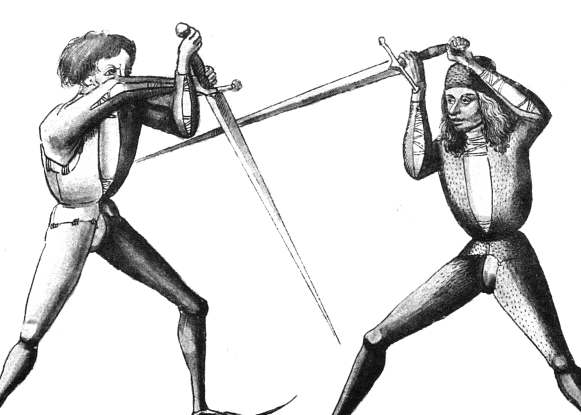
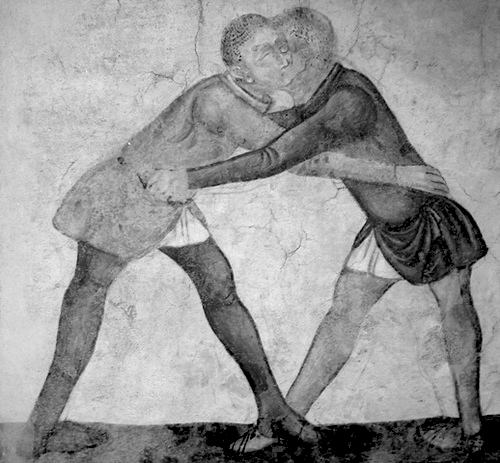
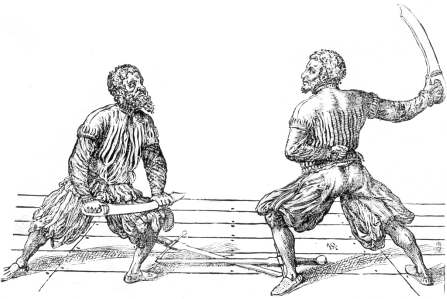
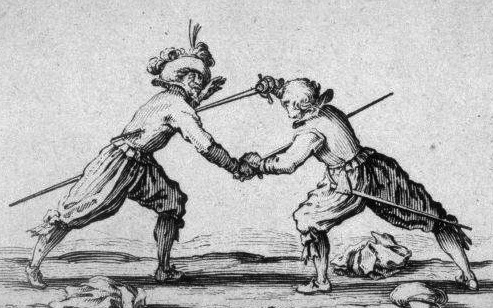
|
Further ARMA activities include:
- Develop
a continually refined and increasingly accurate interpretation of the
historical teachings from the source literature.
- Maintain a practical understanding of how these
principles and concepts were applied by fighting men in actual combat.
- Follow
a broad, pragmatic interpretation of the historical sources that is
focused on earnest physical application of their teachings.
- Refine
a curriculum of martial training and practice through transcriptions,
translations, interpretations, and physical application of the source
literature.
- Encouraging the development of historical
fencing equipment and commercial training gear while supporting and
promoting the production of historically accurate replica swords and
weaponry.
- Promoting interest in and advancement of
Medieval and Renaissance fencing.
- Raising the quality of discourse on the subject
while promoting its investigation.
- Protecting the rights of enthusiasts to
purchase and own accurate replicas of swords and historical weaponry
through legal and legislative action.
- Offering to the public reliable educational
resources and expert guidance on the fighting arts of the late Middle
Ages and Renaissance as well as a consulting service for schools and
the media.
-
Developing and supporting affiliated Study
Groups following the ARMA system and our work to be strong, quick, and
fluid in our techniques.
- Networking with a worldwide community of
historical-fencers and promoting open dialogue and exchange.
Read
more here: ARMA FAQ
|
ARMA's
Affirmations – a declaration of commitment
Good martial arts training does not
just build character, its reveals character.
Our Credo
of Renaissance Martial Arts Studies
Respect
for History and Heritage
Sincerity of Effort
Integrity of Scholarship
Appreciation of Martial Spirit
Cultivation of Self-Discipline
In
studying Renaissance martial arts, we hold the following to be
paramount:
- Offering
instruction in a developed curriculum of Renaissance combat skills that
is historically sound and martially valid.
- Offering
an economically accessible Training Program for Members nationwide.
- Presenting
workshops and seminars worldwide using the ARMA System.
- Providing
for a safe, realistic and practical method of experiencing Medieval
& Renaissance fencing skills.
- Having
realistic and historically accurate Free-Play / Sparring Guidelines
using a friendly, practical, and inexpensive approach.
- Conducting
practice and test-cutting with historically accurate replica weapons.
- Organizing
mock-combat practices and group battle sessions.
- Creating
a membership where prestige and position is based upon combat prowess,
scholarship, and leadership rather than mere longevity or association.
- Being
a community-based, non-profit educational group with
minimal membership fees while avoiding rigidity, bureaucracy,
and authoritarianism.
- Concerning
ourselves with development of real skill in free-play / sparring –not
just getting good at “using a set of sparring rules.”
- Observing
that our mock-fighting does not become idiosyncratic or stylistic.
- Encouraging
the necessity of constant practice, improvement, and scholarship upon
all members.
- Incorporating
actual historical sources and experience with real weapons at every
step of study.
Our
concern is for
the reconstruction and replication of historical combat as safely as
possible without forgetting the intention of training in a true martial
manner. The ARMA methodology is systematic and innovative, but because
the historical source materials are incomplete, either because they are
not compressive or because we have only partial translations, our
interpretations are tentative. Thus, we teach what we have and use our
knowledge and experience to fill in the gaps. We must be ever aware
that only the original author of a text knows exactly what he meant by
each technique, concept, or illustration. Since the old Masters are not
around to tell us, we must interpret their teachings alone. This is
difficult, but also an enjoyable challenge. ARMA's
efforts stand out because we do not assume a priori that all
methods and interpretations are always equal, and we are not about
validating or accommodating every approach, but instead involved with
setting standards for Renaissance martial arts practitioners while
continually challenging students to do better. Our members recognize
this perspective as one that's vigorous and exciting.
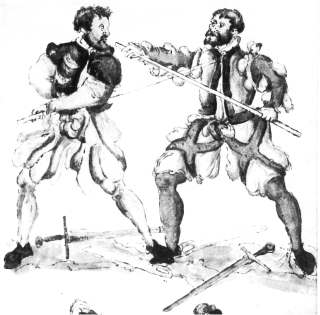 The
ARMA is the only organization of its kind run by a professional
instructor
of historical
European fighting arts with demonstrable mastery over its methods
and techniques. But it is through the collaborative effort
of a fellowship students and researchers that we can best train
ourselves, then train one another. This requires a process
whereby reconstructive interpretation of the historical teachings
involves application of their methods and techniques with correct physicality
(energy, speed, athleticism, martial spirit, and proper mindset). The
ARMA is the only organization of its kind run by a professional
instructor
of historical
European fighting arts with demonstrable mastery over its methods
and techniques. But it is through the collaborative effort
of a fellowship students and researchers that we can best train
ourselves, then train one another. This requires a process
whereby reconstructive interpretation of the historical teachings
involves application of their methods and techniques with correct physicality
(energy, speed, athleticism, martial spirit, and proper mindset).
In
the ARMA approach to historical fencing studies we do not deemphasize
the violence of the subject, we do not deemphasize the athleticism of
the subject, and we do not deemphasize the necessary intensity required
to practice the craft. Correspondingly, we do not exaggerate the
pageantry, courtesy, etiquette, or ritual that may have sometimes
surrounded it.
Being
a part of the old fighting guilds and studying under a master in a
Fechtschule was about much more than having the martial spirit and
physical conditioning to skillfully execute techniques. It was also
about shared values and issues of camaraderie, mutual respect, trust,
and loyalty. Experiencing these things is as much a part of exploring
and celebrating our Renaissance martial heritage as is learning
fighting techniques. It is no less an aspect to revive than
the
skills themselves.
Read
more here:
Doing Things the ARMA Way
Our
Chosen Model and Example
Core Assumptions
and the Exploration of Historical Fencing
"Though there are People of a bad Taste in every
Art or Science,
there are more in that of Fencing than in others,
as well by Reason of little Understanding of some Teachers,
as of the little Practice of some Learners,
who not acting upon a good Foundation,
or long enough, to have a good idea of it,
argue so weakly on this Exercise…"
- Monsieur L'Abbat, 1734
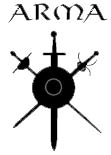 Earnest interest in
Medieval and Renaissance fighting arts has exploded in recent
years. Never before has so much information and effort been
placed into this subject before. We are at the beginning of a new
“renaissance” in the study of Historical European Martial Arts. This is
an exciting time to participate and be a part of a living effort to
revive a forgotten martial art. Come join us in celebrating the art and
science of Renaissance martial arts! Earnest interest in
Medieval and Renaissance fighting arts has exploded in recent
years. Never before has so much information and effort been
placed into this subject before. We are at the beginning of a new
“renaissance” in the study of Historical European Martial Arts. This is
an exciting time to participate and be a part of a living effort to
revive a forgotten martial art. Come join us in celebrating the art and
science of Renaissance martial arts!
Joining ARMA as an official Associate Member offers
many advantages to researchers and practitioners of Medieval and
Renaissance combat. A range of special training tips and study material
is offered in the private member’s section.
Go to the New
Members page for details and application.
|

